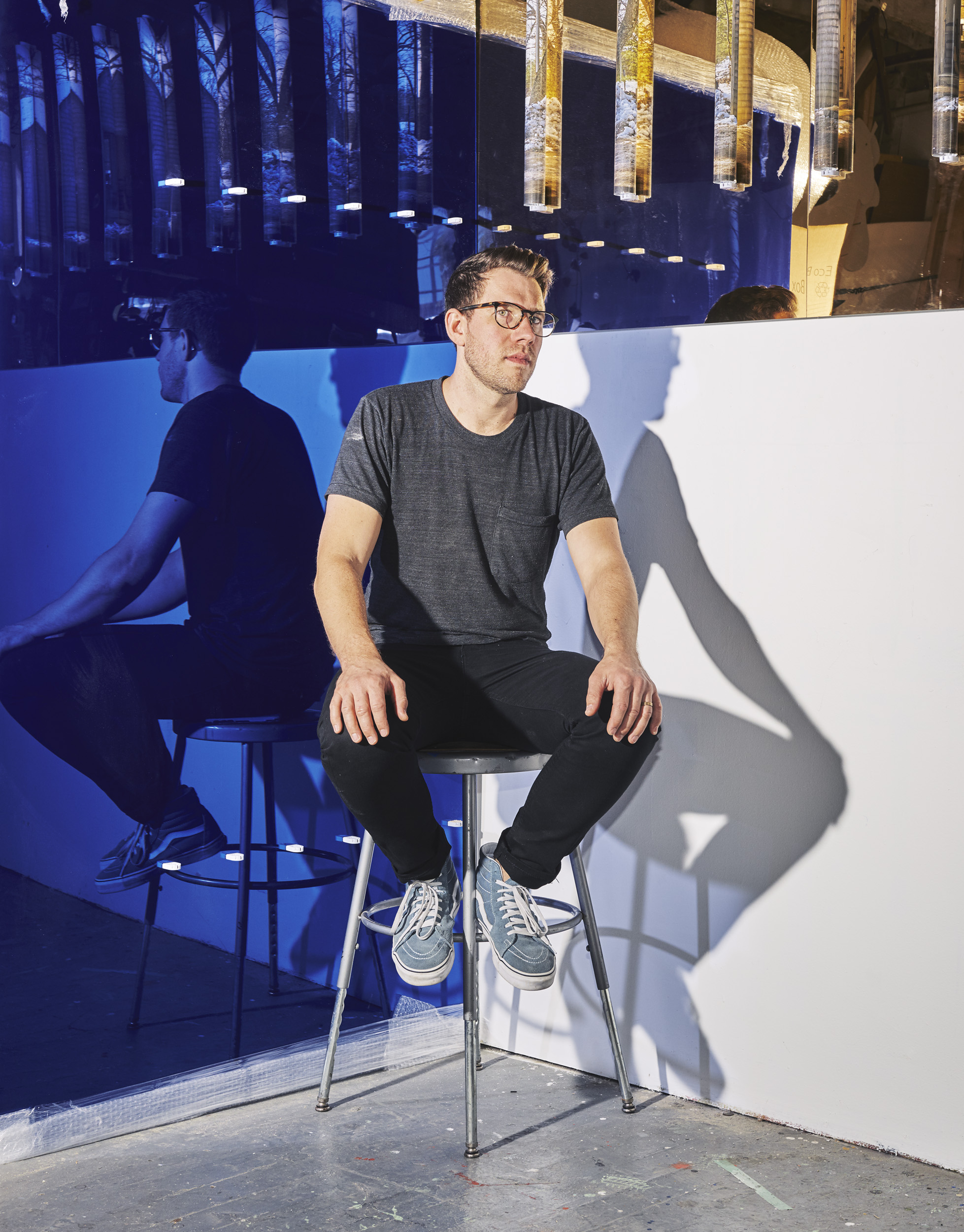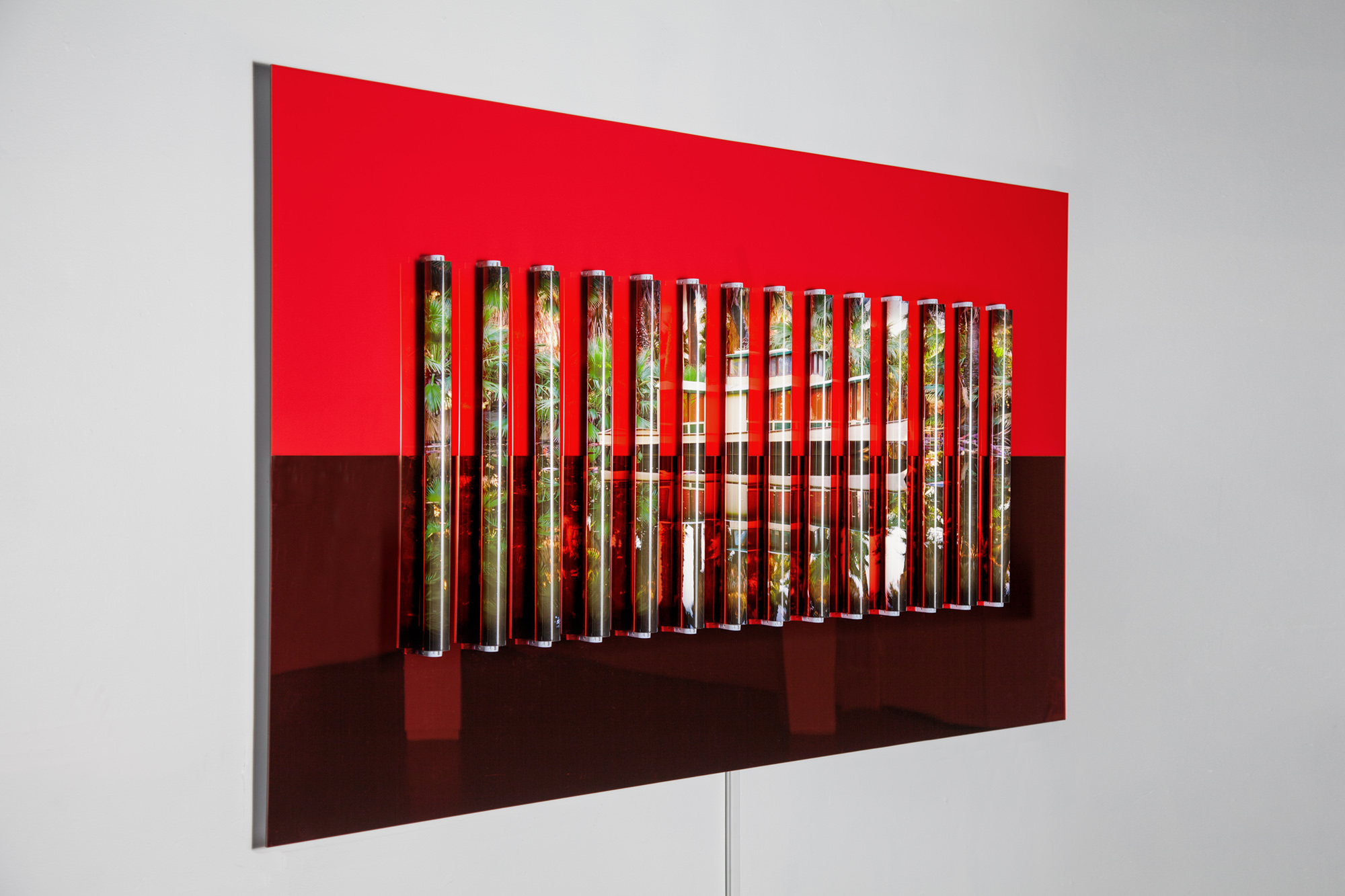Abigail Ogilvy Gallery is thrilled to officially represent the artwork of Clint Baclawski, a Boston-based artist working with photography, technology, light, and space. Working out of 35 Wareham Street studio, Clint transforms his landscape photographs into 3D light installations. He separates his photographs into sections which he wraps around LED light tubes and sets vertically across plexiglass sheets. The result is an interactive and compelling illuminated landscape whose dialogue with the viewer renews and refreshes as the viewer moves along the composition. We recently sat down with Clint to ask him questions about his background, process, and recent work. Check out our interview below.

Photograph of Clint Baclawski by Tony Luong
Abigail Ogilvy Gallery: How has your upbringing influenced your work? What was the original spark that drew you to study photography?
Clint Baclawski: Growing up, I was a Montessori student so, even from a very young age, I’ve always been encouraged to explore my creative interests in the greatest way possible. My older sister, also an artist, attended MICA, originally for photography before switching to painting. She was a constant source of inspiration for me to pursue a creative path. However, it was really my father, a veteran and former state police officer, who inspired me to pick up my first camera at 12 years old. He was a photography hobbyist and invited me to join him for one of the photography darkroom classes he was attending. Since that day, I’ve essentially not put my camera down for the last 25 years.
AOG: Fast-forward several years later, and you’ve graduated with a degree in advertising photography. Why the shift towards fine art? What lessons from advertising have you held onto?
CB: The impetus to major in advertising photography was simply my desire to learn everything I possibly could about cameras and lighting. However, it was never my intention to go into the field of advertising or editorial work as I’ve always been drawn more towards fine art. Despite the early rise of digital photography, I was fortunate enough to be attending an institution, Rochester Institute of Technology, that had such a strong connection to The Eastman Kodak Company and film. The school instilled in me a great love of positive E-6 film, which is the basis of why I continue to shoot exclusively with a large-format camera. My early fascination with light, without my conscious knowledge, was developed during critiques. Instead of presenting images on the wall, we presented our film transparencies on a light table, in order to better develop exposure, technicality, and knowledge.
AOG: What is your creative process like? How do you start a piece? Do you have a vision of the end result?
CB: When I’m conceptualizing my next work, sometimes I start a piece with the photograph, and, other times I will start a piece by considering how I’d like it presented, then hunt for an image which will best align with that vision.
Even with the rise of digital photography during my undergraduate years, I’ve always been drawn to film photography and these days my large format camera is often mistaken for a video camera when it’s on the tripod. The most unique aspect of my process is that I typically only shoot one frame. I either capture the image or I don’t.
I am interested in making each piece uniquely different from the previous one. I’ve enjoyed playing with multiple sizes of lightbulbs, spacing between the bulbs, and the pattern of those bulbs. Also, I’m very loyal to my camera. Everything I’ve shot in the past 15 years has been with the same Horseman camera with a standard 150 lens.

Clint Baclawski, Oasis, 2017. Glossy red Plexiglas and red mirrored Plexiglas on Dibond, archival pigment backlight prints, clear polycarbonate tubes, 2′ LED bulbs 44 x 80 x 3 in.
AOG: You’ve previously spoken about the serendipitous moment of a piece of film draping over a blub and inspiring this new exploration. How do light bulbs differ from your light boxes? What does this medium offer you?
CB: Yes, I entered graduate school in 2006 at MassArt, presenting rather traditional 2-D work. Then, for a few years, inspired by Canadian artist Jeff Wall, I presented my work in custom-built lightboxes. One night, in my studio a piece of discarded photograph fell onto a light table, setting off a figuratively lightbulb in my head, which lead me to begin wrapping my images around them.
On the most basic level, my current light bulb pieces are a deconstruction of the light boxes. As a medium, the lightbulb offers me endless of options of size and scale, which is a departure to the more confined nature of the lightboxes.
AOG: Much of your current photography explores landscapes and architecture, whether it be a houseboat, wind turbines, or a home. Why this theme? What kinds of subject matter are you drawn to?
CB: In the last few years, I’m drawn to photographing places that are generally solitary in nature and were often inhabited but may no longer be. I then use the lightbulbs as a representative symbol of former advertising displays. More recently, after living here for almost 13 years, I’ve finally turned my camera to capture subject matter in New England. Previously, most of the imagery I exhibited was far outside of New England.
AOG: Last fall, you showed Zephyr, an immersive installation in a shipping container for Boston’s HUB week (and recently sold, woohoo congrats). How has this harmony between technology and art, electricity and film, defined your work?
CB: I wouldn’t exactly say defined it but when HUBweek asked me to propose artwork for the shipping container I was intrigued by the concept and felt confident that I already had an image, Zephyr, that strongly represented their theme. Zephyr at HUBweek was really about viewer engagement. The scale allowed the piece to be viewed from different angles, producing a different viewer experience for each person. Some HUBweek viewers preferred the upclose nature of the work, which produces an abstract image, but most prefer to walk along the image until it comes together as one. And, quite honestly, the children who viewed the piece simply loved the lights. As a father, I took particular delight in young people interacting with the work.
AOG: What types of pieces are you working on currently? Do you have any goals or experiments you’re eager to try?
CB: Lately, I’ve been working on a few large-scale site-related proposals and one I am particularly excited about is entitled Fringe. The installation includes new materials and a slight departure from my other image concepts and I look forward to presenting it in the gallery as part of a solo exhibition opening on Friday, September 6, 2019.
—————————
Clint Baclawski’s solo exhibition locations include San Luis Obispo, California; St. Louis, Missouri; Boston, Massachusetts; Edinburgh, Scotland; and group shows at the Chelsea Art Museum, Danforth Museum, Fort Wayne Museum of Art, San Diego Art Institute, and others. His work has been featured in: FRAME magazine, The Boston Globe, The Creator’s Project, Boston Home magazine, Designboom, Take Magazine, and The Collector’s Guide to New Art Photography Volume II. When not in his studio or behind a camera, Clint is a staff member, and teaches Installation Art to graduate students at Massachusetts College of Art and Design.
Add a comment